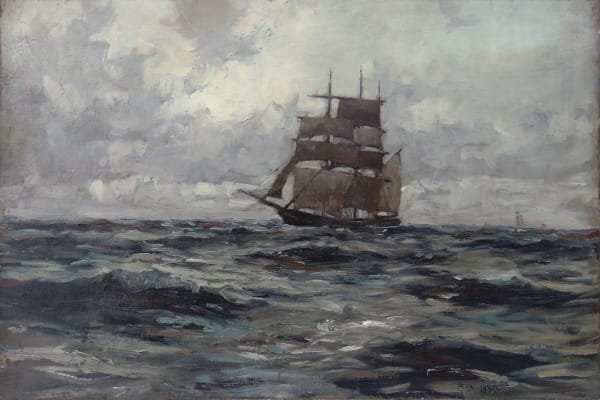Frank Brangwyn 1867-1956
"The whole harbour was filled with boats and men getting ready for the fishing; it was a sight that knocked me silly". Frank Brangwyn writing of his first impressions in Cornwall.
Frank William Brangwyn (registered in his Belgian birthplace as Guillaume François Brangwyn) was born in May 1867 in Bruges, where his father, William Curtis Brangwyn, moved after winning a competition to design a parish church. In 1874 the family moved back to England where William established a successful design practice in London. Frank attended Westminster City School, but whilst still a boy came across Charles Napier Hemy painting by the Thames at Putney. The young Brangwyn spent hours watching the artist, and began to sketch. He skipped school to study and draw in the South Kensington Museum near his father's workshop. With contacts made at the Museum, among them Arthur Mackmurdo, Brangwyn obtained an apprenticeship with William Morris.
At the age of just seventeen one of Brangwyn's paintings was accepted by the Royal Academy Summer Exhibition and sold to a shipowner, strengthening the young man's conviction to become an artist. He joined the Royal Naval Volunteers and whilst performing gunnery drill on the President, an old warship in the West India Dock, he was able to sketch and paint the crew and ship. Later he convinced the shipowner who had bought his Royal Academy picture, to let him sail on a freighter to Istanbul. This trip provided Brangwyn with the material for several notable paintings.
In 1887 a rather impoverished Brangwyn visited Cornwall, sponsored by Frederick Mills who had a reputation for supporting young artists and was the elderly head of a firm of artist's colourmen in Soho. He travelled in steerage on the Waterford Packet, eventually disembarking at Falmouth. Brangwyn was instantly taken by Cornish waterfront life, writing: 'The whole harbour was filled with boats and men getting ready for the fishing; it was a sight that knocked me silly'.
Brangwyn's earliest Cornish subjects, which concentrate on atmosphere and perspective, are quite discreetly toned but demonstrate a command of the en plein-air and square-brush approaches to painting. 'Constructing South Pier, Mevagissey, 1888' (Falmouth Art Gallery) and 'Shipping in open seas, 1889' are such works. These paintings show the strong influence of Stanhope Forbes and the Newlyn School, although there is no evidence that Brangwyn ever went to Newlyn. But such was the association of Brangwyn's style with Newlyn that in 1888, the Royal Academy having accepted the Barkstrippers for its summer exhibition, noted the picture as a 'Newlyn' painting. These early Cornish works are quite rare but demonstrate that despite his youth and lack of any atelier training, Brangwyn was an accomplished en plein-air painter.
Having painted the activity in the Cornish ports of Falmouth, Padstow and Mevagissey, Brangwyn started venturing inland to study the Cornish landscape. His palette grew brighter as he studied the ancient landscape and fields under the crisp Cornish light. Over the following few years, the artist would gradually abandon his earlier tonal style in favour of a more colourist approach. So whereas a painting like Funeral at Sea (Glasgow Museums), which won a medal at the Paris Salon in 1891, was mostly composed in grey; a painting like The Golden Horn, Constantinople (Sothebys New York, April 2007), is much brighter and full of colour.
Brangwyn held his first one-man show in London in 1891 and was one of the founders of the Chelsea Art Club. He spent most of that year at sea, visiting Spain several times as well as returning to Istanbul and travelling to South Africa and Zanzibar. The emerging colourist in Brangwyn was attracted by the light and the vibrant hues of these southern countries at a time when Orientalism was becoming a favoured theme for many painters. The new energy and brightening of his work did not find critical favour initially in the UK but established his international reputation; in 1895 the French government purchased his painting, 'Market in Morocco'.
At the start of the new century Brangwyn was commissioned to create many epic size murals and mosaics including a commission from John D. Rockefeller, Jr. to decorate the concourse of the RCA Building in New York with murals. In 1926 the artist was commissioned by Lord Iveagh to paint a pair of large canvases for the Royal Gallery at the House of Lords in remembrance of peers who had been killed in the war. Brangwyn painted two battle scenes which included life-size images of troops advancing into battle. The Lords regarded the panels as too grim and refused to accept them. They instead commissioned Brangwyn to produce the British Empire Panels; a series intended to fill the Royal Gallery. Brangwyn spent five years producing 16 large works that covered 3,000 sq feet. Rather outrageously, the peers again refused to accept the finished product; this time because they were "too colourful and lively". Fortunately, in 1934 the 16 panels were purchased by Swansea Council and are now housed in the Brangwyn Hall, Swansea.
However, the Lords' rejections and the time invested naturally had a lasting impact upon Brangwyn. He became despondent and began disposing of his possessions during the 1930s. He donated many of his own and other artworks to museums and galleries in Britain and Europe including the British Museum. In 1936 he presented Bruges with over 400 works, now in the Arents House Museum. In return Bruges made him Citoyen d'Honneur de Bruges, only the third time this honour has been awarded. The two battle scenes rejected by the House of Lords were donated to the National Museum Wales as part of a large group of gifts he made to the Museum between 1929 and 1935. In 1944, he recovered and secured designs by Frederic Shields for the Chapel of the Ascension built by Herbert Horne, which was destroyed in 1940 during the London Blitz. In 1950, one of his last commissions was to provide illustrations for the book Sixty Years of Yachts by his friend Herbert Julyan.
In his last years Brangwyn lived at his home in Ditchling, Sussex and died there on 11 June 1956. The artist's lifetime's productivity was immense; it is estimated that Brangwyn produced over 12,000 works and that his mural commissions would cover over 22,000 sq feet of canvas not to mention over 1,000 oil paintings, 606 mixed media works, 400 wood engravings and woodcuts, 280 lithographs, 40 architectural designs and 230 designs for furniture.
Boyd James D (1967) Drawings of Sir Frank Brangwyn, R.A., 1867-1956, Humanities Press Intl.
Bunt, Cyril George Edward (1958) The water-colours of Sir Frank Brangwyn, R.A., 1867-1956, F Lewis Publishers
Galloway, Vincent (1962) The Oil and Mural Paintings of Sir Frank Brangwyn R.A. 1867-1956, F. Lewis Publishers
Gaunt W (1926) The Etchings of Frank Branwyn, R.A – A Catalogue Raisonne, The Studio
Naylor, Gillian and Horner, Libby (2006) Frank Brangwyn 1867-1956
Salaman, Malcolm C (1932) Modern Masters of Etching. FRANK BRANGWYN, R.A., The Studio




